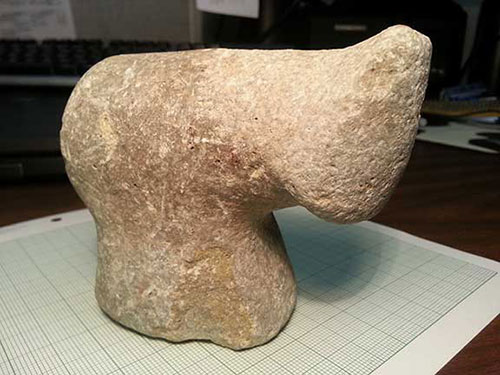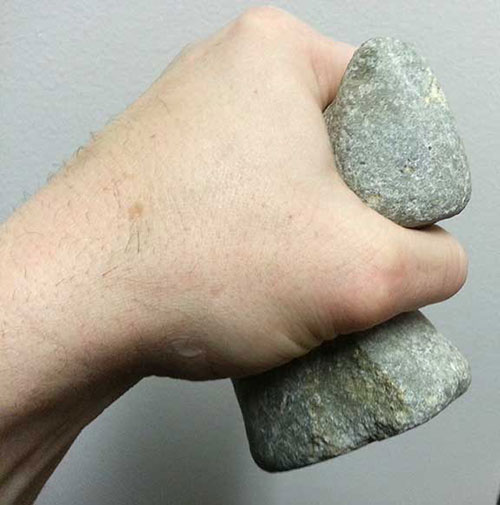
Prehistoric Stone Maul Discovered at Starrigavin Slide Area
March 10, 2015
Tuesday PM
(SitNews) Sitka, Alaska - In January 2015, Tongass National Forest Hydrologists Marty Becker and KK Prussian discovered an oddly weathered stone while collecting, sampling, and identifying rock samples in the Starrigavin slide area.
“I thought it was just a cool weathered rock and held it in my hand and started walking back down to KK,” said Becker. As I was walking, it suddenly hit me this thing is really comfortable and took a closer look at it, realized what I thought it was, showed it to KK and got the same assumption from her.”

The maul shows minor signs of damage from being churned among the soil rocks and trees in the landslide. There are much older signs of damage to the maul likely from the time of original use; one of the ears or tangs was broken off. There are also signs of use wear around the striking surface.
Photo courtesy USFS
What Becker and Prussian had found was confirmed by Forest Service Archaeologist Jay Kinsman as a prehistoric stone tool more succinctly a T-shaped hand maul. This type of stone tool is common in Northwest Coast Native Cultures extending from the Columbia River to Yakutat. A tool of this type is akin to a prehistoric hammer or sledge hammer. This tool would have likely been used for driving wedges made of a softer material such as wood, antler, or sea-mammal along a cedar log to split off planks.
It is likely that the former owner of this maul was utilizing cedar for one of the many resources derived from it (planks) on the slopes above Starrigavin creek. The owner would have likely cached the maul and wedges for future use rather than haul them back and forth with load of cedar planks.

This type of stone tool hammer was common in Northwest Coast Native Cultures.
Photo courtesy USFS
The artifact will become part of the permanent artifact collection of the Tongass National Forest. The Museum of the North is the curation facility that the Alaska Region uses to permanently curate collections.
The September 2014 landslides caused by high rainfall affected approximately 75 to 100 acres in Starrigavan Valley, about 10 miles from Sitka.
Edited by Mary Kauffman, SitNews
Source of News:
USFS - Tongass National Forest
www.fs.fed.gov
Publish A Letter in SitNews
Contact the Editor
SitNews ©2015
Stories In The News
Ketchikan, Alaska
|
Articles &
photographs that appear in SitNews may be protected by copyright
and may not be reprinted without written permission from and
payment of any required fees to the proper sources.
E-mail your news &
photos to editor@sitnews.us
Photographers choosing to submit photographs for publication to SitNews are in doing so granting their permission for publication and for archiving. SitNews does not sell photographs. All requests for purchasing a photograph will be emailed to the photographer.
|
|


